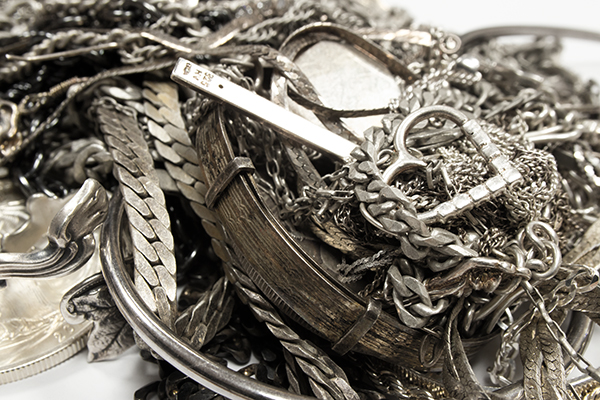
Anyone who has owned silver, whether in the form of jewellery, personal effects, household items or bullion products, is aware that the shiny precious metal can become discoloured by tarnish. But what tarnishes silver and where can we learn how to clean tarnished silver?
In the case of Sterling Silver, which is an alloy of 925 parts silver with 75 parts other metals, usually copper, tarnish is predominantly due to the reaction of the base metal constituents with sulphur in the air. This reaction produces copper sulphide as a layer on the item’s surface which changes colour as the layer of tarnish grows. Hence, an initial yellow discolouration changes through reddish-brown to blue and eventually to black over time. This reaction can be seen very quickly if a silver spoon is exposed to the sulphur-rich yolk of a boiled egg.
Whilst some people welcome tarnish on items as it can give an impression of age and an antique look, in the main it is regarded as a nuisance at the very least.
Purer silver, particularly 999 investment grade silver bars and silver coins bullion products, are less susceptible to tarnish but will still discolour over time as silver sulphide develops on the surface of the item, particularly when stored in poor conditions.
Ideally, silver should be stored in dry conditions with a relative humidity of less than 50%. The use of domestic gel packs which absorb moisture or even a few sticks of chalk can be helpful in reducing humidity in storage. Special tarnish reducing bags and cloths can be utilised to slow the tarnishing process of items in storage but the use of wooden draws and storage cupboards is not advised as the wood can retain moisture which will accelerate the process.
Avoid handling items with your bare hands as human perspiration and fingerprints contain oils and salts that can trigger a corrosive reaction with silver. Whenever possible wear cotton or vinyl gloves and avoid contact between silver and woollen fabrics as wool has a high sulphur content.
If we assume that airtight, temperature and humidity controlled storage facilities are beyond the purse of most owners of silver then we must accept that tarnish to our silver, to some degree, is inevitable.
This then leads to the question of how to clean tarnished silver. As mentioned above, some owners like to see tarnish on items as it gives an antique look. Indeed, one US silver bullion manufacturer in particular actually promotes a wooden storage box system to aid the tarnishing process to produce an ‘old west’ style patina on products.
For those owners who reject the idea of tarnish on silver there is a vast array of specialist cleaning products available ranging from light cleaning cloths to pastes and dips. More drastic solutions can be seen when searching online but frequent use of harsh solutions is likely to cause damage. Indeed, any form of cleaning is going to reveal a surface that tarnish is free to attack again. There is an argument that cleaning actually encourages tarnish to flourish.
If you do decide to clean silver, the best advice is to proceed gently. Use the least harsh method available and always test your cleaning method on an inconspicuous area of the tarnished silver first.
If you have a tried and tested ‘go to’ solution for how to clean tarnished silver then feel free to share it via [email protected] and we will pass on your tips.
















